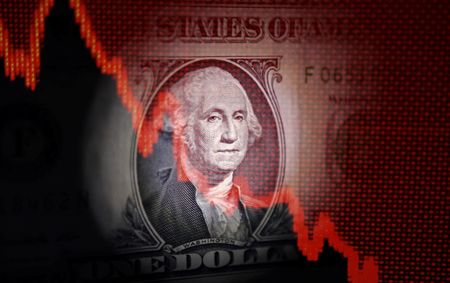By Saqib Iqbal Ahmed
NEW YORK (Reuters) -Large U.S. multinationals should soon start showing the positive effects of the dollar’s tumble in recent months, reversing the situation in the past few years when the greenback’s strength hurt companies with significant foreign revenue.
The Dollar Index, which measures the buck’s strength against six major currencies, is down about 10% for the year, due to rapidly changing U.S.
trade policy and worries about U.S. growth and government debt.
About half of that drop happened since April 2, when U.S. President Donald Trump announced outsized import tariffs against trading partners that started a panic about investing in U.S.
assets.
For the April-June period, the index, which is heavily weighted toward the euro, averaged 99.74, down 6.5% from the first quarter average, the largest such decline over consecutive quarters in more than 30 years.
The effects of the dollar’s slide are expected to start showing up in second-quarter earnings season just getting underway.
While that dollar’s fall reflects investor worries about the U.S.
economy’s strength, it can help some companies. A weaker U.S. currency makes it cheaper for multinational companies to convert foreign profits into dollars, while also boosting the competitiveness of exporters’ products.
“It’s an absolutely huge move,” Greg Boutle, head of U.S.
equity & derivative strategy at BNP Paribas, said. “It is going to flatter earnings a little bit this quarter and also feed its way to guidance.”
The dollar’s impact on overall earnings is usually small, but can grow more meaningful when the currency experiences a large swing.
Every 10% drop in the dollar translates into a profit surprise of about 2%, at the S&P 500 level, according to estimates from research and strategy firm Macro Hive.
That would be welcomed by investors increasingly worried about the earnings impact of evolving trade and tariff policies. The second-quarter profit reporting season started this week.
“Whatever the beat, miss or forward guidance was going to be without the FX effect will obviously be a little bit better with it,” Boutle said.
The dollar’s weakness this year, after a 7% rise in 2024, which hurt corporate results last year, took many market watchers by surprise.
“Certainly a lot of companies came into the year assuming a headwind ….
That’s flipped. That’s a positive for earnings,” Patrick Kaser, portfolio manager at Brandywine Global, said.
While earnings growth is expected to decelerate from the first quarter, the weaker dollar could help to offset possible tariff effects.
Analysts are forecasting second-quarter earnings growth of 5.8% year-over-year compared with 13.7% in the first quarter, LSEG data show.
Even in the first quarter, the dollar was a drag on year-over-year S&P 500 earnings growth of about 1%, but now could lift earnings growth by about 0.5% in the second quarter, according to David Lefkowitz, head of U.S.
equities at UBS Global Wealth Management.
“If the dollar stays at these levels, the boost on a year-over-year basis will get progressively larger,” Lefkowitz said, estimating the dollar could generate a lift to year-over-year S&P 500 earnings growth by about 1% and 1.5% for the third and fourth quarter respectively.
FOREIGN EXPOSURE
S&P 500 companies generate about 41% of their revenue from outside the United States, according to FactSet.
Companies with major exposure to the Asia-Pacific region are particularly in focus with the euro having appreciated 12% against the buck while the yen is up about 6%.
However, not all index constituents are equally affected by the dollar’s swings.
The information technology sector tops the list with the most international revenue exposure, at about 55%, followed by the materials and communication services sectors, at 52% and 49%, respectively, according to FactSet.
For instance, on Tuesday, BMO Capital Markets analyst Brian Pitz lifted his second-quarter revenue growth estimate for Netflix to 17.2% from 16.4%, largely boosted by a weaker dollar.
Netflix will report results on Thursday.
Investors are divided on the impact of a weaker dollar on stock prices. Some, like UBS’s Lefkowitz, believe any benefits are already priced in by Wall Street and will not significantly move markets during earnings reports, but others still anticipate a positive boost.
“A lot of buy-side investors are obviously very acutely aware of this already, but nevertheless, we do think it’s not in sell-side consensus numbers,” BNP’s Boutle said.
“So we just think it creates a mechanical tailwind for earnings.”
Still, analysts cautioned against counting on a big lift to stock prices from earnings beats driven by the weaker dollar.
Many companies, including chipmakers, which stand to benefit from a weaker dollar, are also the ones most vulnerable to a hit from tariffs, Macro Hive research analyst Viresh Kanabar said.
Investors may also be preoccupied with the potential impacts companies could see from the recent passage of the sweeping tax-cut and spending bill.
“In an environment where nothing else was going on, the move in the dollar would matter,” Brandywine’s Kaser said. “With all these other things going on, I don’t think the currency effect is going to be as big as in an environment that maybe is quieter from a macroeconomic and geopolitical side of things.”
(Reporting by Saqib Iqbal Ahmed; Editing by Alden Bentley and Richard Chang)











